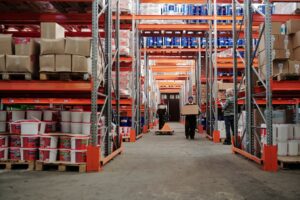What is a Flexible Manufacturing System (FMS)?
A flexible manufacturing system is a methodology that enables companies to be flexible in the face of changes like market demand, manufacturing challenges, or opportunities for innovation. Whether these changes are predictable or not, FMS companies quickly shift their production to meet the needs of their business and the market.
Typically, FMS involves organizing and connecting workstations with a central computer that manages and tracks the production process while feeding materials and data to the production line/machines. While the system enables manufacturers to fully automate their system while maintaining production flexibility, two of the main disadvantages are that it is extremely complex and expensive to set up.
Although FMS is predominantly a systematic approach to manufacturing, it is also a philosophy that companies can apply to their own operations without spending a dime.
KEY TAKEAWAYS
A Flexible Manufacturing System (FMS) is a systematic approach to automated manufacturing that is adaptable to changes in the production line.
Ideally, this system enables production lines to change quantity and product type quickly.
There are 4 types of flexibility: Volume, Mix, Manufacturing, and Delivery.
FMS is most often regarded as a specific technology but it is also a philosophy that enables many production environments to achieve agile practices.
What Does Flexible Mean Within FMS?
Within the context of manufacturing, flexibility refers to the ability to change aspects of a production line based on market requirements and production environments.
For example, mass production environments are naturally rigid since customers have come to expect little product variation from them. Although, even mass production environments benefit from flexible practices that affect volume and delivery. On the other hand, companies that are involved in mixed-model manufacturing or ATO/MTO environments require greater levels of flexibility so that change can be quickly enacted based on external factors like:
The market demand;
Resource availability;
Workforce ability.
4 Types of Flexibility
Volume Flexibility is the ability to change and adjust production volumes. This enables companies to adjust resources and times without negatively impacting their ROI.
Mix Flexibility is the ability to produce a wide range of products or variations of the same product. This allows companies to respond quickly to respond to market demand.
Manufacturing Flexibility is the ability to control production despite the normal uncertainties of manufacturing. Despite changes and unforeseen issues, the production recovers and adapts to the required resources and workforce requirements.
Delivery Flexibility is the ability for customers to set their desired delivery dates and lead times.
For each of these flexibility types to work, there is a certain measure of flexible practices that need to be integrated directly into the production system. This can be done with automated process lines, connected machines, and/or advanced smart manufacturing systems like VKS.
How Does FMS Work?
For any system or operation to be flexible, it needs to be connected. There need to be strong lines of communication that facilitate collaboration between production segments. Otherwise, the system will break as the segments work independently.
For FMS environments, 3 core elements bind the whole system together:
Work Machines: These are the machines that perform the physical work. Includes material presses, CNC machines, etc.
Material Handling System: This system keeps a steady flow of materials for the work machines. This can be automated by machines and/or tracked and managed by material handler personnel
Central Control Computer: This is the brain of the operation, managing material movements, machine flow, required pieces, and more.
As machines perform the work, materials are constantly flowing to maintain a steady and theoretically unending flow. The central control computer is managing quantities while also tracking key production data and machine/process health information.
Example of Flexible Management System
Imagine you have just received a large contract to fabricate a wide variety of construction bolts and screws. You’ll need to fabricate drywall screws, steel screws, chrome-plated bolts, copper bolts, and more.
There’s only one issue: You don’t have the space nor the required amount of dedicated machines to create each bolt/screw variant. Plus, you don’t have enough staff to run this operation 24/7, which is what you will need to meet your contract.
Luckily, you have figured this out already and have some time to prepare a Flexible Manufacturing System. You set up your CNC machines to begin creating the steel construction screws. Steel is loaded into the machine automatically from your inventory by the material handling system. Once the CNC machine completes the required amount of steel screws, it will automatically send a message to the central control computer asking to begin producing a new product – in our case, copper bolts. The material handling system loads the CNC machine with copper and the operation is quickly producing the required copper bolts.
Changeover between products is fast and simple. If you multiply this over several machines, production is virtually unstoppable. The only con is that setting up this type of system comes with some hefty upfront costs.
How to Make Any Production Line Flexible
If you don’t have an automated production system and material handler machines, or if your production doesn’t fit a complex fully automated system, there are still ways for you to take the best parts of FMS and apply them to your operation.
As we covered, FMS is a system and a philosophy that hinges its success on strong connections between production segments. If we apply this to a manual process (with some Industry 4.0 innovation), we can achieve the same, if not better, results.
Each production relies on people. Using tools like our work instruction software enables your workers to seamlessly communicate with their teams, machines, and systems. Despite shifts in market demand or production challenges, VKS opens the doorway for manufacturers of all types to apply smart, flexible, and fast-acting practices to their operations.


